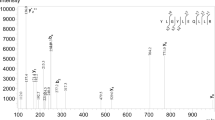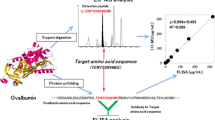Abstract
A mass spectrometry immunoassay (MSIA) specifically designed for the detection of egg allergens in wines is described. MSIA is based on an immunoaffinity enrichment procedure combined with targeted MS/MS detection of selected egg peptide markers. Polyclonal antibodies raised against native ovalbumin, chosen as the target protein tracing for egg powder, were immobilized onto low backpressure monolithic MSIA customized disposable tips. Ovalbumin-free wine samples were fortified with standard protein at different concentrations in the low microgram-per-milliliter range. A simple protocol was devised consisting of a 1:4 dilution of the wine sample with a basic solution for pH adjustment, followed by a semi-automated purification/enrichment step on MSIA customized disposable tips fitted on a multichannel electronic pipette. Among the main figures of merit, LOD and LOQ values as low as 0.01 and 0.03 μg/mL, respectively, and within-day precision of 18% should be noticed. Noteworthy, the developed assay outperformed current MS-based methods for the detection of allergenic protein in wine matrices, thanks to the immunoaffinity enrichment. In addition, compared to other immunoassays, the present approach boasts the unquestionable advantage of providing an unambiguous identification of the target protein by simultaneous detection of three unique peptide markers each giving three specific MS/MS transitions.





Similar content being viewed by others
References
EFSA Panel on Dietetic Products, Nutrition and Allergies. Scientific opinion related to a notification from the International Organisation of Vine and Wine (OIV) on casein/caseinate/milk products to be used in the manufacture of wine as clarification processing aids pursuant to Article 6, paragraph 11 of Directive 2000/13/EC—for permanent exemption from labeling. EFSA J. 2011;9:2384–97.
European Commission. COMMISSION REGULATION (EC) No 607/2009 of 14 July 2009 laying down certain detailed rules for the implementation of Council Regulation (EC) No 479/2008 as regards protected designations of origin and geographical indications, traditional terms, labeling and presentation of certain wine sector products. Off J Eur Union. 2009;L193:60–80.
European Commission. Commission Implementing Regulation (EU) No 579/2012 of 29 June 2012 amending Regulation (EC) No 607/2009 laying down certain detailed rules for the implementation of Council Regulation (EC) No 479/2008 as regards protected designations of origin and geographical indications, traditional terms, labeling and presentation of certain wine sector products. Off J Eur Union. 2012;L171:4–7.
European Commission. Council Regulation (EC) No 1234/2007. Off J Eur Union. 2007;L299:1–343.
International Organisation of Vine and Wine (OIV). Criteria for the methods of quantification of potentially allergenic residues of fining agent proteins in wine. Resolution OIV/OENO 427/2010. 2010. http://www.oiv.int/en/technical-standards-and-documents/resolutions-oiv/oenology-resolutions. Accessed 26 July 2016.
International Organisation of Vine and Wine (OIV). Criteria for the quantification of potentially allergenic residues of fining agent proteins in wine. OIV-OENO 427-2010 modified by OIV/Comex 502-2012. 2012. http://www.oiv.int/en/technical-standards-and-documents/resolutions-oiv/oenology-resolutions. Accessed 26 July 2016.
Cucu T, Jacxsens L, De Meulenaer B. Analysis to support allergen risk management: which way to go? J Agric Food Chem. 2013;61:5624–33.
Monaci L, Visconti A. Immunochemical and DNA-based methods in food allergen analysis and quality assurance perspectives. Trends Food Sci Technol. 2010;21:272–83.
Peñas E, di Lorenzo C, Uberti F, Restani P. Allergenic proteins in enology: a review on technological applications and safety aspects. Molecules. 2015;20:13144–64.
Lacorn M, Ristow R, Weiss T, Immer U. Collaborative tests of ELISA methods for the determination of egg white protein and caseins used as fining agents in red and white wines. Food Anal Methods. 2014;7:417–29.
Restani P, Uberti F, Tarantino C, Ballabio C, Gombac F, Bastiani E, et al. Collaborative interlaboratory studies for the validation of ELISA methods for the detection of allergenic fining agents used in wine according to the criteria of OIV resolution 427-2010 modified by OIV-Comex 502-201. Food Anal Methods. 2014;7:706–12.
Monaci L, Visconti A. Mass spectrometry-based proteomics methods for analysis of food allergens. Trends Anal Chem. 2009;28:581–91.
Monaci L, Pilolli R, De Angelis E, Mamone G. Mass spectrometry in food allergen research. In Picó Y, editor. Comprehensive analytical chemistry. Elsevier Science and Technology; 2015. p. 359–393.
D’Amato A, Kravchuk AV, Bachi A, Righetti PG. Noah’s nectar: the proteome content of a glass of red wine. J Proteome. 2010;73:2370–7.
Cereda A, Kravchuk AV, D’Amato A, Bachi A, Righetti PG. Proteomics of wine additives: mining for the invisible via combinatorial peptide ligand libraries. J Proteome. 2010;73:1732–9.
Losito I, Introna B, Monaci L, Minella S, Palmisano F. Development of a method for the quantification of caseinate traces in Italian commercial white wines based on liquid chromatography-electrospray ionization-ion trap-mass spectrometry. J Agric Food Chem. 2013;61:12436–44.
Tolin S, Pasini G, Curioni A, Arrigoni G, Masi A, Mainente F, et al. Mass spectrometry detection of egg proteins in red wines treated with egg white. Food Control. 2012;23:87–94.
Tolin S, Pasini G, Simonato G, Mainente F, Arrigoni G. Analysis of commercial wines by LC-MS/MS reveals the presence of residual milk and egg white allergens. Food Control. 2012;28:321–6.
Mattarozzi M, Milioli M, Bignardi C, Elviri L, Corradini C, Careri M. Investigation of different sample pre-treatment routes for liquid chromatography–tandem mass spectrometry detection of caseins and ovalbumin in fortified red wine. Food Control. 2014;38:82–7.
Monaci L, Losito I, De Angelis E, Pilolli R, Visconti A. Multiallergen quantification of fining related egg and milk proteins in white wines by high-resolution mass spectrometry. Rapid Commun Mass Spectrom. 2013;27:2009–18.
Pilolli R, De Angelis E, Godula M, Visconti A, Monaci L. Orbitrap™ monostage MS versus hybrid linear ion trap MS: application to multi-allergen screening in wine. J Mass Spectrom. 2014;49:1254–63.
De Angelis E, Pilolli R, Monaci L. Coupling SPE on-line pre-enrichment with HPLC and MS/MS for the sensitive detection of multiple allergens in wine. Food Control. 2016. doi:10.1016/j.foodcont.2016.09.031. on-line first.
Madian AG, Rochelle NS, Regnier FE. Mass-linked immuno-selective assays in targeted proteomics. Anal Chem. 2013;85:737–48.
Nelson RW, Krone J, Bieber AL, Williams P. Mass spectrometric immunoassay. Anal Chem. 1995;67:1153–8.
Krastins B, Prakash A, Sarracino DA, Nedelkov D, Niederkofler EE, Kiernan UA, et al. Rapid development of sensitive, high-throughput, quantitative and highly selective mass spectrometric targeted immunoassays for clinically important proteins in human plasma and serum. Clin Biochem. 2013;46:399–410.
Yassine H, Borges CR, Schaab MR, Billheimer D, Stump C, Reaven P, et al. Mass spectrometric immunoassay and MRM as targeted MS-based quantitative approaches in biomarker development: potential applications to cardiovascular disease and diabetes. Proteomics Clin Appl. 2013;7:528–40.
Gauthier MS, Pérusse JR, Awan Z, Bouchard A, Tessier S, Champagne J, et al. A semi-automated mass spectrometric immunoassay coupled to selected reaction monitoring (MSIA-SRM) reveals novel relationships between circulating PCSK9 and metabolic phenotypes in patient cohorts. Methods. 2015;81:66–73.
Trenchevska O, Schaab MR, Nelson RW, Nedelkov D. Development of multiplex mass spectrometric immunoassay for detection and quantification of apolipoproteins C-I, C-II, C-III and their proteoforms. Methods. 2015;81:86–92.
Oran PE, Trenchevska O, Nedelkov D, Borges CR, Schaab MR, Rehder DS, et al. Parallel workflow for high-throughput (>1,000 samples/day) quantitative analysis of human insulin-like growth factor 1 using mass spectrometric immunoassay. Plos One. 2014;9:e92801.
Peterman S, Niederkofler EE, Phillips DA, Krastins B, Kiernan UA, Tubbs KA, et al. An automated, high-throughput method for targeted quantification of intact insulin and its therapeutic analogs in human serum or plasma coupling mass spectrometric immunoassay with high resolution and accurate mass detection (MSIA-HR/AM). Proteomics. 2014;14:1445–56.
Ueda K, Ishikawa N, Tatsuguchi A, Saichi N, Fujii R, Nakagawa H. Antibody-coupled monolithic silica microtips for high-throughput molecular profiling of circulating exosomes. Sci Rep. 2014;4:1–9.
Lesur A, Ancheva L, Kim YJ, Berchem G, van Oostrum J, Domon B. Screening protein isoforms predictive for cancer using immunoaffinity capture and fast LC-MS in PRM mode. Proteomics Clin Appl. 2015;9:695–705.
Such-Sanmartín G, Bache N, Bosch J, Gutiérrez-Gallego R, Segura J, Jensen ON. Detection and differentiation of 22 kDa and 20 kDa growth hormone proteoforms in human plasma by LC-MS/MS. Biochim Biophys Acta. 1854;2015:284–90.
Knoop A, Thomas A, Fichant E, Delahaut P, Schänzer W, Thevis M. Qualitative identification of growth hormone-releasing hormones in human plasma by means of immunoaffinity purification and LC-HRMS/MS. Anal Bioanal Chem. 2016;408:3145–53.
Kiernan UA, Phillips DA, Nedelkov D, Niederkofler EE, Krastins B, Sarracino DA, Peterman S, Prakash A, Garces A, Lopez MF. Comparative performance evaluation of the mass spectrometric immunoassay (MSIA™) and magnetic bead formats. Application Notes MSIA1002; 1–4
Pilolli R, Visconti A, Monaci L. Rapid and label-free detection of egg allergen traces in wines by surface plasmon resonance biosensor. Anal Bioanal Chem. 2015;407:3787–97.
Pilolli R, Monaci L. Challenging the limit of detection for egg allergen detection in red wines by surface plasmon resonance biosensor. Food Anal Methods. 2016;9:2754–61.
Uberti F, Danzi R, Stockley C, Peñas E, Ballabio C, Di Lorenzo C, et al. Immunochemical investigation of allergenic residues in experimental and commercially-available wines fined with egg white proteins. Food Chem. 2014;159:343–52.
Deckwart M, Carstens C, Webber-Witt M, Schäfer V, Eichhorn L, Schröter F, et al. Impact of wine manufacturing practice on the occurrence of fining agents with allergenic potential. Food Addit Contam Part A. 2014;31:1805–17.
Meyer P, Zanetti S. Detection of traces of ovalbumin and casein in white and red wines by quantitative western blotting. J Food Sci. 2015;80:T2102–9.
Acknowledgements
The authors thank Thermo Fisher Scientific for the technical support and for providing custom MSIA™ D.A.R.T.’S™ and Finnpipette™ Novus I Multichannel Electronic Pipette. The authors also acknowledge Aurelio Dipalo for his technical help.
Author information
Authors and Affiliations
Corresponding author
Ethics declarations
Funding
This research did not receive any specific grant from funding agencies in the public, commercial, or not-for-profit sectors.
Conflict of interest
R.P. declares that she has no conflict of interest. L.M. declares that she has no conflict of interest. F.P. declares that he has no conflict of interest. R.C. is an EMEA Specialist for MSIA platform at Thermo Fisher Scientific.
Ethical approval
This article does not contain any studies with human participants or animals performed by any of the authors.
Informed consent
Not applicable.
Rights and permissions
About this article
Cite this article
Pilolli, R., Chaudhari, R., Palmisano, F. et al. Development of a mass spectrometry immunoassay for unambiguous detection of egg allergen traces in wines. Anal Bioanal Chem 409, 1581–1589 (2017). https://doi.org/10.1007/s00216-016-0099-3
Received:
Revised:
Accepted:
Published:
Issue Date:
DOI: https://doi.org/10.1007/s00216-016-0099-3




